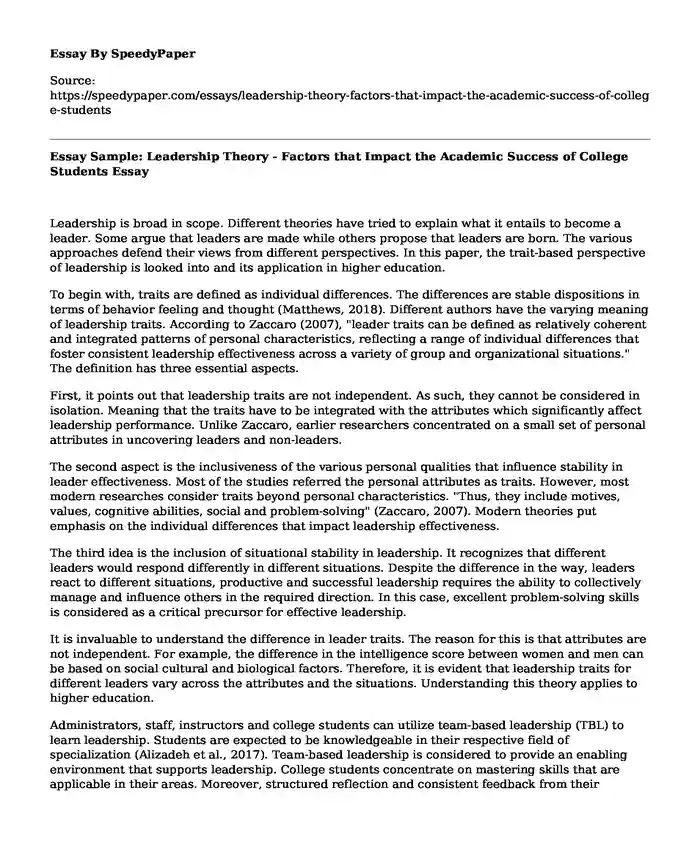
| Type of paper: | Essay |
| Categories: | Leadership analysis College Leadership style |
| Pages: | 3 |
| Wordcount: | 615 words |
Leadership is broad in scope. Different theories have tried to explain what it entails to become a leader. Some argue that leaders are made while others propose that leaders are born. The various approaches defend their views from different perspectives. In this paper, the trait-based perspective of leadership is looked into and its application in higher education.
To begin with, traits are defined as individual differences. The differences are stable dispositions in terms of behavior feeling and thought (Matthews, 2018). Different authors have the varying meaning of leadership traits. According to Zaccaro (2007), "leader traits can be defined as relatively coherent and integrated patterns of personal characteristics, reflecting a range of individual differences that foster consistent leadership effectiveness across a variety of group and organizational situations." The definition has three essential aspects.
First, it points out that leadership traits are not independent. As such, they cannot be considered in isolation. Meaning that the traits have to be integrated with the attributes which significantly affect leadership performance. Unlike Zaccaro, earlier researchers concentrated on a small set of personal attributes in uncovering leaders and non-leaders.
The second aspect is the inclusiveness of the various personal qualities that influence stability in leader effectiveness. Most of the studies referred the personal attributes as traits. However, most modern researches consider traits beyond personal characteristics. "Thus, they include motives, values, cognitive abilities, social and problem-solving" (Zaccaro, 2007). Modern theories put emphasis on the individual differences that impact leadership effectiveness.
The third idea is the inclusion of situational stability in leadership. It recognizes that different leaders would respond differently in different situations. Despite the difference in the way, leaders react to different situations, productive and successful leadership requires the ability to collectively manage and influence others in the required direction. In this case, excellent problem-solving skills is considered as a critical precursor for effective leadership.
It is invaluable to understand the difference in leader traits. The reason for this is that attributes are not independent. For example, the difference in the intelligence score between women and men can be based on social cultural and biological factors. Therefore, it is evident that leadership traits for different leaders vary across the attributes and the situations. Understanding this theory applies to higher education.
Administrators, staff, instructors and college students can utilize team-based leadership (TBL) to learn leadership. Students are expected to be knowledgeable in their respective field of specialization (Alizadeh et al., 2017). Team-based leadership is considered to provide an enabling environment that supports leadership. College students concentrate on mastering skills that are applicable in their areas. Moreover, structured reflection and consistent feedback from their instructors help them to make an important milestone in their journey towards acquiring leadership capability (Alizadeh et al., 2017). It helps them to become self-aware. Therefore, the administrators and staff should be willing to provide guidance to the students so that they may have a better understanding of the importance of working in teams as it influences once traits.
In summary, traits and behavior are essential aspects. One of them cannot be considered in isolation of the other. It becomes evident in situations which makes the leaders act differently. Thought inborn, traits can change for one to become an effective leader. Interaction with others helps to shape leadership skills. Hence, guiding students to work in teams can help to develop their leadership skills.
References
Alizadeh, M., Mirzazadeh, A., Parmelee, D. X., Peyton, E., Janani, L., Hassanzadeh, G., & Nedjat, S. (2017). Uncover it, students would learn leadership from Team-Based Learning (TBL): The effect of guided reflection and feedback. Medical teacher, 39(4), 395-401.
Matthews, G. (2018). Cognitiveadaptive trait theory: A shift in perspective on personality. Journal of personality, 86(1), 69-82.
Zaccaro, S. J. (2007). Trait-based perspectives of leadership. American psychologist, 62(1), 6.
Cite this page
Essay Sample: Leadership Theory - Factors that Impact the Academic Success of College Students. (2022, Nov 22). Retrieved from https://speedypaper.net/essays/leadership-theory-factors-that-impact-the-academic-success-of-college-students
Request Removal
If you are the original author of this essay and no longer wish to have it published on the SpeedyPaper website, please click below to request its removal:
- Critical Appraisal
- Periods of Life. Essay Samples.
- Free Essay Sample about Malpractice Cases in Healthcare
- Clinical Trials Going Global - Essay Example
- A Literary Essay Sample on the Of Love and Other Demons Novel
- Free Essay Sample on Improving Interpersonal Communication
- Free Paper Sample: IKEA Analysis Report
Popular categories




